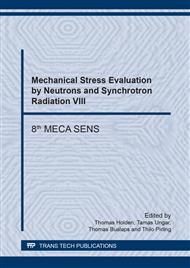p.123
p.131
p.137
p.143
p.151
p.157
p.165
p.174
p.182
New Developments of the Materials Science Diffractometer STRESS-SPEC
Abstract:
The high flux neutron diffractometer STRESSSPEC at FRM II, Garching Germany, offers a flexible instrument setup suitable for fast and surface residual strain measurements. Likewise bulk, local or gradient texture analyses are feasible. Here improvements of the hardware (detector, slits) of the instrument as well as developments on methods for residual stress analysis are presented. A new detector system developed inhouse was recently installed and successfully commissioned. Compared to the original delay line detector the new detector provides much higher resolution and allows event mode type measurements. Results of the commissioning measurements show a performance increase of nearly a factor of 2 compared to the former detector. Moreover the new analytical model, recently developed for surface spurious strain corrections, was successfully applied at a welded austenitic steel sample. Thus nondestructive measurements from the surface (200 μm) into the bulk (several millimeters) are possible without any extra time consuming experiments for spurious strains corrections.
Info:
Periodical:
Pages:
151-156
Citation:
Online since:
August 2017
Price:
Сopyright:
© 2017 Trans Tech Publications Ltd. All Rights Reserved
Share:
Citation:


